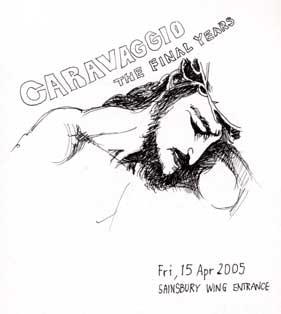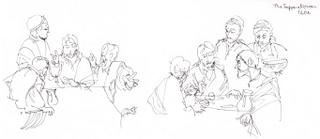Caravaggio 2005
National Gallery
Caravaggio- The Final Years exhibition
April 2005
I was itching to start sketching again, and Dreen's visit to London provided the perfect opportunity to check out the Caravaggio exhibition.
Going for art exhibitions, unfortunately tend to be a stressful activity these days. If possible I go on a day when there are fewer people. Unfortunately Caravaggio is one of the highlights in the National Gallery's calendar. No escaping the crowds!
 (Thoughts on chiarusco realism and influence on film, to be posted soon)
(Thoughts on chiarusco realism and influence on film, to be posted soon)Admittedly the scrawls are a little rough from lack of practice. It's not easy trying to draw, whilst so many people are milling around in the filled-up warm rooms, some stopping to watch. I could feel my heart pumping in my throat, a sweat bead trailing down my back. It's often compared to riding a bicycle. When you get going (even if I hadn't sketched for a few years now) you go into auto mode, your being surrenders to receiving and remembers how much pleasure was derived from drawing. Pulling lines longer to form tangible traces of memory. If I could not remember coming to this place, the sketches will remind me of just the emotion of standing in awe of some of these great paintings.
Some might argue it is 'copying' but I beg to differ. Even photographing something exactly as you saw it, it still involves contemplation, processing and interpretation. Copies are things like photocopies or duplicates of prints, word for word, material for material, with exactly the same texture and lighting. I suppose for me it's almost like recording an emotion or something I saw in the painting. If the painting or picture arrests me more, I might re-visit it and see something else.
Two depictions of the same theme, span the years of his great success. Left version was made in 1601, "helped establish Caravaggio as his generation's most innovation and powerful interpreter of biblical subjects. He returned to the theme only once, in the painting on the right, made in the summer of 1606 before he fled Rome. Caravaggio generally developed towards a darker, more emotionally expressive style, but this became especially marked in this 2nd version of The Supper at Emmaus. His earlier preoccupation with the description of physical reality gives way to a preference for probing the psychological truth of his subject."*
 Portrait of a Knight of Malta, 1607-8;
Portrait of a Knight of Malta, 1607-8;
(possibly Fra. Antoni Martelli?)If you grew up within a strict Christian mission school where Biblical stories are told with such grandeur and vivid imagery, chances are you will be stuck throughout your life with powerful stark images oscillating between Heaven and Hell. The latter when you are of an age that started to distinguish certain things are good, others are bad, no grey in between. The grey period is whilst you are on Earth struggling with the Aim and Meaning of your life.
These strong images remind me of that period of my life when I was pretty serious about spirituality. I think possibly my first initiation into art and painting was these religious paintings. I remember wanting to possess the whole collection of art volumes (rare to give any room to these oversized books) in the school library.
 Portrait of a Knight of Malta, 1607-8;
Portrait of a Knight of Malta, 1607-8;What strikes me is his proud pose, and how the Maltese cross is emblazoned across his chest. The posture you will find Veterans have when they are on parade. Or when an elderly man is ballroom dancing with his wife, as they waft in and out of the only lit doorway you can see of the gym. Even the spotlighting seems to agree.
"Using concise brushwork, he masterly defines the play of light across skin, silk and iron, and establishes the sense of a real, thought-possessed individual. The man's left hand is on his sword while the right plays with rosary beads, signifying the dual profession of knight and friar."*
I still wonder what Joseph thought of the whole thing. How challenged his faith has be in order to embrace this child which is not his doing, and take his wife's word of Immaculate Conception, and if this is all to be true also knowing this child is probably the Messiah whom he has to worship and adore. When I was younger it was a story of wonderment of the shepherds and wise men with the arrival of baby Jesus. I guess over the years, it became more about what if I was in the shoes of the human person, which is ironically closer to who we are than the holier-than-the-other-person stance?
"... Salome's outward gaze, her eyes unflinching and hollow, her look cold but enigmatic. An unsettling void emphasises her dark presence. The bowed heads establish a mood of sorrow, while their detached expressions lend gravity and a fatalistic air to the scene."*
What a b* (4-letter word sounds like bleach), you might say. Hell hath no fury like a woman scorned! John the Baptist was chucked into prison for rebuking King Herod Antipas who married his brother's wife Herodias - then ends up on a plate. For Herodias, yay back to the life she was accustomed to. Her daughter Salome gets to continue her dancing lessons. John's head (not the tongue that got him into trouble) as proof of how the King's word was set in stone. You could deduce, the King has lost his head! Too many grapes swallowed whilst reclining, I say.
I wonder what happened to his head after that, did they merrily eat it over dinner? I think of the smiling pig's head and ears BBQ-ed to perfection, golden brown and yummy-looking, on the table at a village feast. Did John's head afford such a display? I wonder if Salome felt anything when a severed human head was brought to her, she probably didn't know what the fuss was about, possibly never even met the man. Eek gross, ahem ... but a splendid wax artwork for the pedestal in m-ma's prayer room!
"Caravaggio amplifies the horror of this scene with the dramatic outward thrust of the severed head, its mouth open as if still preaching. The executioner's gesture effectively defers blame for his task, and his head is echoed by Salome's to accentuate her culpability, even if she turns away. Her glance is inscrutable, perhaps cold and cunning, perhaps unable to confront the deed ... The bleak colour, summary execution and sharp highlights suggest this might be the painting that Caravaggio sent to appease the Grand Master of the Knights of Saint John after his return to naples in 1609."*
Dreen is a Caravaggio fan, she teaches art. This is her favourite painting. I'll ask her why, maybe she can add her comments below.
"The archangel Gabriel's announcement of the conception of Christ. The angel's face is strangely hidden by his shoulder, so that the import of the awesome declaration is instead carried in the tautness of his arm. The archangel's gesture indicates acclamation or blessing as well. The kneeling figures are starkly mirrored, emphasising the contrast between Mary's humble acceptance and the angel's ecstatic tension."*
Something to be said about Mary's position or posture. I suppose if I were in her shoes, I would not be too happy about having to tell my new husband - 'Hey hon, guess what, the angel Gabby yeah you know that one, dropped by during tea and announced with blaring fanfare, trumpets and all, and you're not going to believe this, that I am to be the Mother of Christ. Within my head I am thinking ... will I get a choice to say no thank you very much?'
Note: * Text credit: accompanying exhibition guide from National Gallery.
Watch out for my Frida Kahlo exhibition thoughts, to be posted soon.
Also to come, other sketches from the National Gallery, when I wandered off into other rooms nearby the Caravaggio exhibition.






0 Comments:
Post a Comment
<< Home